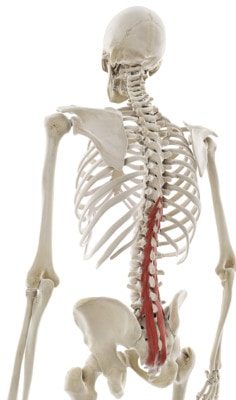Back Fusion Outcome: Fusion Leads to Dead Multifidus
Decisions in Medicine like most things are based on risk vs. benefit. There are life saving procedures and surgeries where the answer is clear, but in non emergency situations, are we doing greater good than harm? A new study looks at the potential damage done to the multifidus in the common surgery, back fusion.

Multifidus muscles. SciePro/Shutterstock
So what is the multifidus and why should you care? First, the spine is like a series of blocks stacked one upon the other creating structure and containing and protecting the spinal cord. It’s held together by ligaments and kept stable by a series of muscles called multifidus. Damage to the ligaments and atrophy of the multifidus can cause instability. Fusion surgery is done when vertebrae become so unstable that they allow the type of movement that affects the nerves or just causes pain. Basically, hardware and screws “fix” two or more vertebrae together and create an umovable section of the spine.
The new study observed six patients who underwent lumbar fusion surgery and used ten healthy individuals as a control. They received pre-operative, and post-operative Cross Sectional Area MRI’s to evaluate the condition and contractibility of the their multifidus at all levels of their lumbar spine. The results were that was very significant damage was to the multifidus at the operated levels. Given that other studies have shown that the amount of multifidus damage is directly related to the length of time a surgical retractor is used, the result isn’t surprising. Also concerning, is that the study showed that the muscles that helps to move the back (the paraspinals) were also smaller and damaged in patients who underwent fusions.
The upshot? Making two or more vertebrae “fixed” and immovable simply puts more stress and load on the vertebrae above and below the fusion which causes degenerative arthritis. But the issue here is that in order for the level of instability to develop to necessitate a fusion, the multifidus muscles were not functioning properly, and cutting through them to reach the vertebrae to be fused damages them irrevocably. Considering back fusion outcome does the surgery do greater good than harm? To answer that question you need to look at the alternative. Stabilizing the ligaments and multifidus can be accomplished without fusion surgery and with targeted injections and exercises. So is surgery the answer?

NOTE: This blog post provides general information to help the reader better understand regenerative medicine, musculoskeletal health, and related subjects. All content provided in this blog, website, or any linked materials, including text, graphics, images, patient profiles, outcomes, and information, are not intended and should not be considered or used as a substitute for medical advice, diagnosis, or treatment. Please always consult with a professional and certified healthcare provider to discuss if a treatment is right for you.
